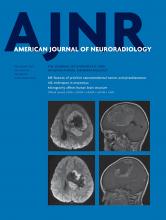Index by author
Feng, F.
- Adult BrainOpen AccessMiddle Cerebral Artery Plaque Hyperintensity on T2-Weighted Vessel Wall Imaging Is Associated with Ischemic StrokeY.-N. Yu, M.-W. Liu, J.P. Villablanca, M.-L. Li, Y.-Y. Xu, S. Gao, F. Feng, D.S. Liebeskind, F. Scalzo and W.-H. XuAmerican Journal of Neuroradiology November 2019, 40 (11) 1886-1892; DOI: https://doi.org/10.3174/ajnr.A6260
Fletcher, J.G.
- FELLOWS' JOURNAL CLUBPatient SafetyOpen AccessEvaluation of Lower-Dose Spiral Head CT for Detection of Intracranial Findings Causing Neurologic DeficitsJ.G. Fletcher, D.R. DeLone, A.L. Kotsenas, N.G. Campeau, V.T. Lehman, L. Yu, S. Leng, D.R. Holmes, P.K. Edwards, M.P. Johnson, G.J. Michalak, R.E. Carter and C.H. McColloughAmerican Journal of Neuroradiology November 2019, 40 (11) 1855-1863; DOI: https://doi.org/10.3174/ajnr.A6251
Projection data from 83 patients undergoing unenhanced spiral head CT for suspected neurologic deficits were collected. A routine dose was obtained using 250 effective mAs and iterative reconstruction. Lower-dose configurations were reconstructed (25-effective mAs iterative reconstruction, 50-effective mAs filtered back-projection and iterative reconstruction, 100-effective mAs filtered back-projection and iterative reconstruction, 200-effective mAs filtered back-projection). Three neuroradiologists circled findings, indicating diagnosis, confidence, and image quality. The routine-dose jackknife alternative free-response receiver operating characteristic figure of merit was 0.87. Noninferiority was shown for 100-effective mAs iterative reconstruction and 200-effective mAs filtered back-projection, but not for100-effective mAs filtered back-projection. The authors conclude that substantial opportunity exists for dose reduction using spiral nonenhanced head CT and that the dose level might potentially be reduced to 40% of routine dose levels or a volume CT dose index of approximately 15mGy if slight decreases in performance are acceptable. The beneficial effect of iterative reconstrution was most pronounced at this 15-mGy dose level.
Flood, T.F.
- Pediatric NeuroimagingYou have accessAge-Dependent Signal Intensity Changes in the Structurally Normal Pediatric Brain on Unenhanced T1-Weighted MR ImagingT.F. Flood, P.R. Bhatt, A. Jensen, J.A. Maloney, N.V. Stence and D.M. MirskyAmerican Journal of Neuroradiology November 2019, 40 (11) 1824-1828; DOI: https://doi.org/10.3174/ajnr.A6254
Fornage, B.D.
- Head and Neck ImagingYou have accessDiagnostic Accuracy and Scope of Intraoperative Transoral Ultrasound and Transoral Ultrasound–Guided Fine-Needle Aspiration of Retropharyngeal MassesT.H. Vu, M. Kwon, S. Ahmed, M. Gule-Monroe, M.M. Chen, J. Sun, B.D. Fornage, J.M. Debnam and B. Edeiken-MonroeAmerican Journal of Neuroradiology November 2019, 40 (11) 1960-1964; DOI: https://doi.org/10.3174/ajnr.A6236
Fouladi, M.
- Pediatric NeuroimagingOpen AccessMRI Features of Histologically Diagnosed Supratentorial Primitive Neuroectodermal Tumors and Pineoblastomas in Correlation with Molecular Diagnoses and Outcomes: A Report from the Children's Oncology Group ACNS0332 TrialA. Jaju, E.I. Hwang, M. Kool, D. Capper, L. Chavez, S. Brabetz, C. Billups, Y. Li, M. Fouladi, R.J. Packer, S.M. Pfister, J.M. Olson and L.A. HeierAmerican Journal of Neuroradiology November 2019, 40 (11) 1796-1803; DOI: https://doi.org/10.3174/ajnr.A6253
Gagoski, B.
- EDITOR'S CHOICEPediatric NeuroimagingYou have accessComparison of CBF Measured with Combined Velocity-Selective Arterial Spin-Labeling and Pulsed Arterial Spin-Labeling to Blood Flow Patterns Assessed by Conventional Angiography in Pediatric MoyamoyaD.S. Bolar, B. Gagoski, D.B. Orbach, E. Smith, E. Adalsteinsson, B.R. Rosen, P.E. Grant and R.L. RobertsonAmerican Journal of Neuroradiology November 2019, 40 (11) 1842-1849; DOI: https://doi.org/10.3174/ajnr.A6262
This study assesses the accuracy of combined velocity-selective arterial spin-labeling and traditional pulsed arterial spin-labeling CBF measurements in pediatric Moyamoya disease, with comparison with blood flow patterns on conventional angiography. Twenty-two neurologically stable pediatric patients with Moyamoya disease and 5 asymptomatic siblings without frank Moyamoya disease were imaged with velocity-selective arterial spin-labeling, pulsed arterial spin-labeling, and DSA (patients). Qualitatively, velocity-selective arterial spin-labeling perfusion maps reflect the DSA parenchymal phase, regardless of postinjection timing. Conversely, pulsed arterial spin-labeling maps reflect the DSA appearance at postinjection times closer to pulsed arterial spin-labeling postlabeling delay, regardless of vascular phase. ASPECTS comparison showed excellent agreement between arterial spin-labeling and DSA, suggesting velocity-selective arterial spin-labeling and pulsed arterial spin-labeling capture key perfusion and transit delay information, respectively. Velocity-selective arterial spin-labeling offers a powerful approach to image perfusion in pediatric Moyamoya disease due to transit delay insensitivity.
Ganesh, H.
- Patient SafetyYou have accessDose Reduction While Preserving Diagnostic Quality in Head CT: Advancing the Application of Iterative Reconstruction Using a Live Animal ModelF.D. Raslau, E.J. Escott, J. Smiley, C. Adams, D. Feigal, H. Ganesh, C. Wang and J. ZhangAmerican Journal of Neuroradiology November 2019, 40 (11) 1864-1870; DOI: https://doi.org/10.3174/ajnr.A6258
Gao, S.
- Adult BrainOpen AccessMiddle Cerebral Artery Plaque Hyperintensity on T2-Weighted Vessel Wall Imaging Is Associated with Ischemic StrokeY.-N. Yu, M.-W. Liu, J.P. Villablanca, M.-L. Li, Y.-Y. Xu, S. Gao, F. Feng, D.S. Liebeskind, F. Scalzo and W.-H. XuAmerican Journal of Neuroradiology November 2019, 40 (11) 1886-1892; DOI: https://doi.org/10.3174/ajnr.A6260
Gautam, A.
- Pediatric NeuroimagingOpen AccessDiffusion Characteristics of Pediatric Diffuse Midline Gliomas with Histone H3-K27M Mutation Using Apparent Diffusion Coefficient Histogram AnalysisM.S. Aboian, E. Tong, D.A. Solomon, C. Kline, A. Gautam, A. Vardapetyan, B. Tamrazi, Y. Li, C.D. Jordan, E. Felton, B. Weinberg, S. Braunstein, S. Mueller and S. ChaAmerican Journal of Neuroradiology November 2019, 40 (11) 1804-1810; DOI: https://doi.org/10.3174/ajnr.A6302
George, M.S.
- EDITOR'S CHOICEAdult BrainOpen AccessProlonged Microgravity Affects Human Brain Structure and FunctionD.R. Roberts, D. Asemani, P.J. Nietert, M.A. Eckert, D.C. Inglesby, J.J. Bloomberg, M.S. George and T.R. BrownAmerican Journal of Neuroradiology November 2019, 40 (11) 1878-1885; DOI: https://doi.org/10.3174/ajnr.A6249
Brain MR imaging scans of National Aeronautics and Space Administration astronauts were retrospectively analyzed to quantify pre- to postflight changes in brain structure. Local structural changes were assessed using the Jacobian determinant. Structural changes were compared with clinical findings and cognitive and motor function. Long-duration spaceflights aboard the International Space Station, but not short-duration Space Shuttle flights, resulted in a significant increase in the percentage of total ventricular volume change (10.7% versus 0%). The percentage of total ventricular volume change was significantly associated with mission duration but negatively associated with age. Pre- to postflight structural changes of the left caudate correlated significantly with poor postural control, and the right primary motor area/midcingulate correlated significantly with a complex motor task completion time. These findings suggest that brain structural changes are associated with changes in cognitive and motor test scores and with the development of spaceflight-associated neuro-optic syndrome.








